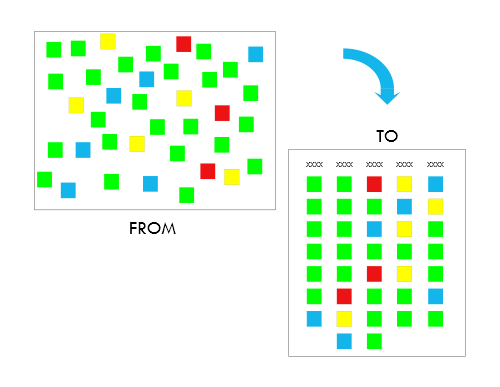Our second in the series of Business Analysis topics is the Affinity Diagram.
I view the Affinity Diagram as more of a tool or process vs. a diagram. It provides for large amounts of ideas to be sorted into groups based on the relationship of the ideas. It works best in brainstorming session(s) where a number of apparent diverse ideas have been identified. The Affinity Diagram process takes these ideas, assembles them into logical groups, and then provides a title or designation for each of the groupings.
These groups can then be used to better understand…
- Field studies
- User functions as part of a design – operational or systematic
- Analyze findings from a usability study
- As the factors in a Cause and Effect Analysis.
Using an Affinity Diagram
As mentioned earlier, the Affinity process works best as part of a brainstorming session.
Step 1 – It starts with a statement of the problem or the goal. For our example let’s use:
How to improve my golf game?
Step 2 – Using Post-Its, have the group write each of their ideas for the problem/goal on a Post-It. Then either individually or as a group the ideas are placed on the wall. At this point, the ideas can begin to be loosely categorized as they are being placed on the wall. This will be the initial pass at sorting, with a more collaborative effort done later.
For the problem above you may have these individual ideas:
- Get better golf clubs
- Play a better golf ball
- Choose better partners to play with
- Upgrade golf clubs
- Join a men’s/women’s golf club
- Play more golf
- Take a lesson
- Go to the driving range more often
- Get golf clubs fitted to my swing
- Learn more about the golf swing
- Practice my short game
- Improve my mental approach to the game
- Play a golf ball that better suits your game
Step 3 – Once all the ideas have been identified, review each and begin to sort similar ideas together in groups. For the individual ideas above, the team groups them as follows:
- Get better golf clubs
- Upgrade golf clubs
- Get golf clubs fitted to my swing
- Play a better golf ball
- Play a golf ball that better suits your game
- Choose better partners to play with
- Join a men’s/women’s golf club
- Learn more about the golf swing
- Improve my mental approach to the game
- Play more golf
- Take a lesson
- Go to the driving range more often
- Practice my short game
So this is a pretty good first pass at grouping as a team. A few things to remember during this process:
- Clarify any ideas where it may not be clear
- Get the group to agree to the groupings
- You can copy an idea to multiple groupings, if it makes sense
- Does it make sense to combine smaller groupings or move them to another group?
- Should larger groups be broken down into smaller/more concise group?
So for our ideas, the team decides that we should combine two of the initial groupings:
- Get better golf clubs
- Upgrade golf clubs
- Get golf clubs fitted to my swing
- Play a better golf ball
- Play a gold ball that better suits your game
Both groups are addressing equipment, so it makes sense to combine them.
Step 4 – Now that we have our groups sorted, time for the final step – identify a title or designation for each group. Something to remember – don’t try to title the groups too early. Wait until all the ideas have been confirmed to be in the right groups. This allows for ideas to be generated and not encumbered by trying to identity only ideas that fall within certain groups. It also makes sense to hold off naming the groups because you now can review all the ideas and determine a more appropriate title.
- Equipment
- Get better golf clubs
- Upgrade golf clubs
- Get golf clubs fitted to my swing
- Play a better golf ball
- Play a gold ball that better suits your game
- Mental Approach
- Choose better partners to play with
- Join a men’s/women’s golf club
- Learn more about the golf swing
- Learn to improve my mental approach
- Practice
- Play more golf
- Take a lesson
- Go to the driving range more often
- Practice my short game
So we now have your Affinity Diagram! I can now use this to build a plan to improve my golf game.
Depending on the purpose of the exercise – i.e., better understand of user functions, usability evaluation, or a starting point for a Cause and Effect analysis – you now have the information for your next steps. You may even come up a different use for the outcome of this process.
If you need help with performing an Affinity Diagram or the next steps, please contact us for assistance.

0 Comments
Leave A Comment